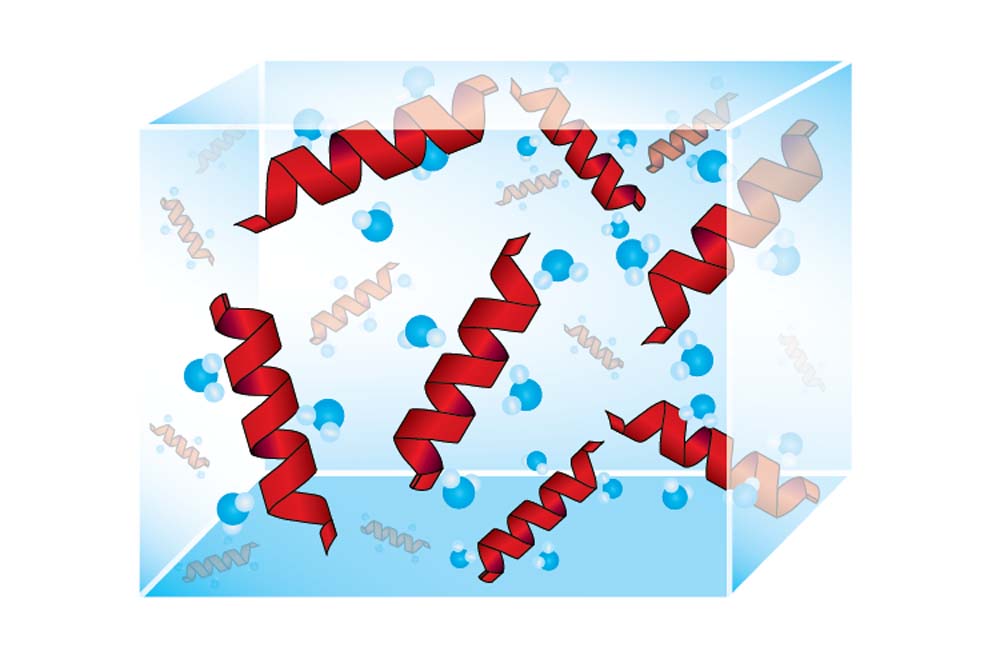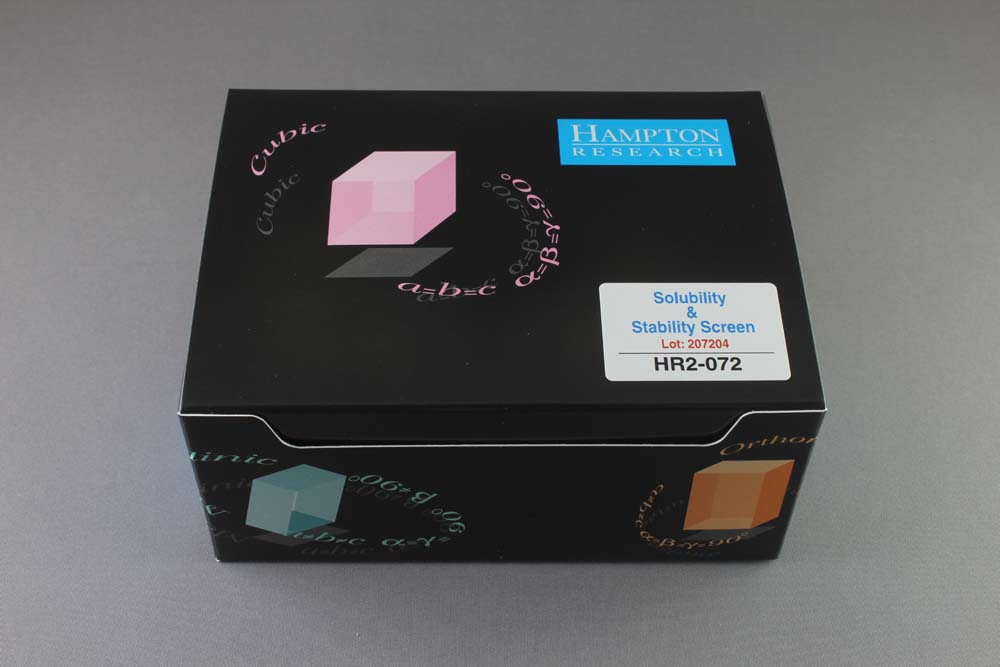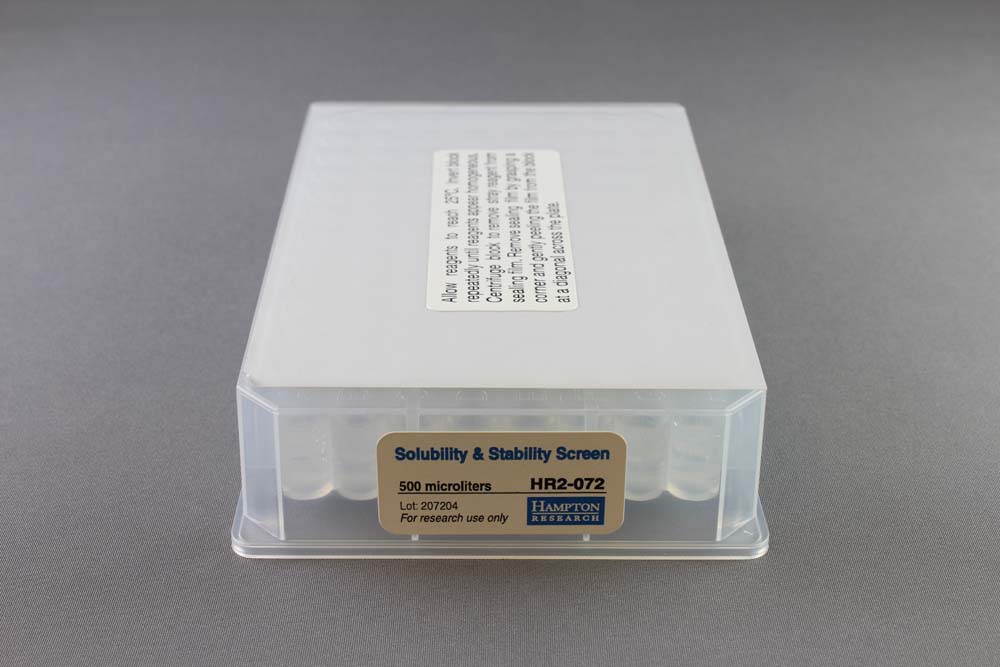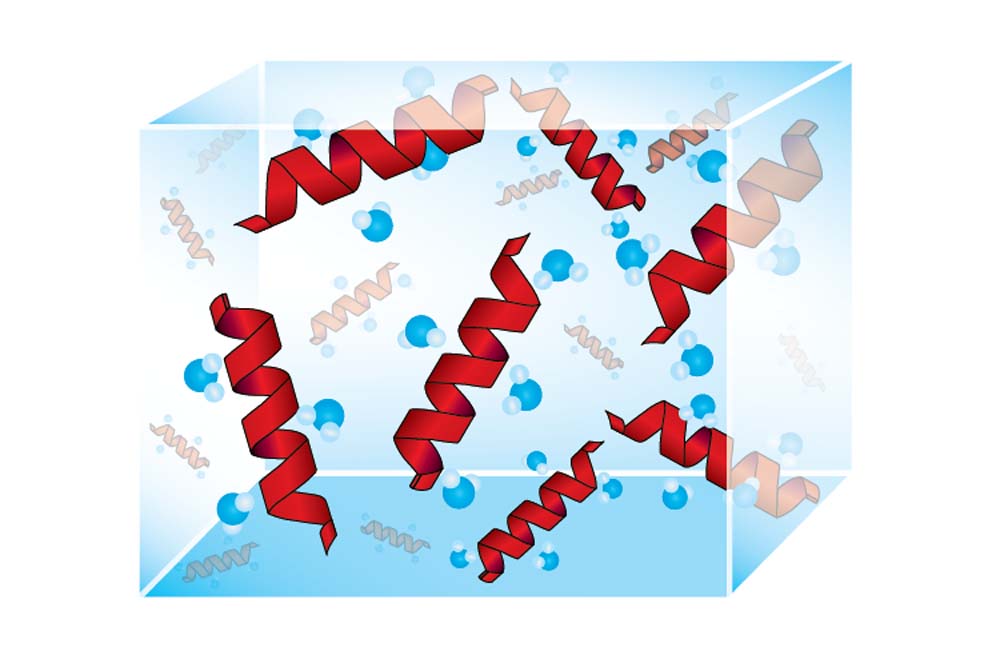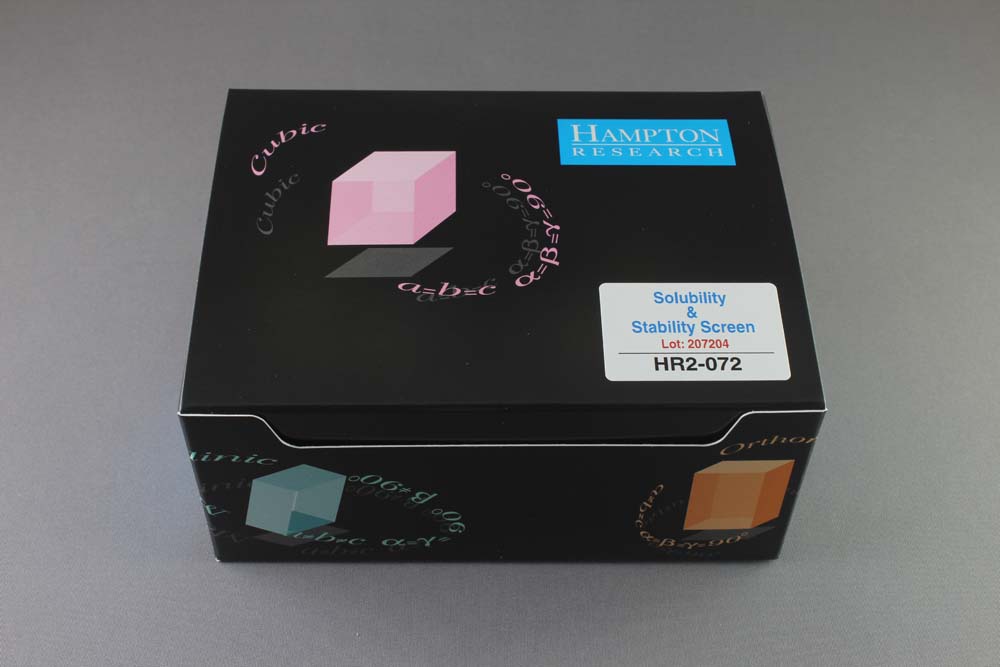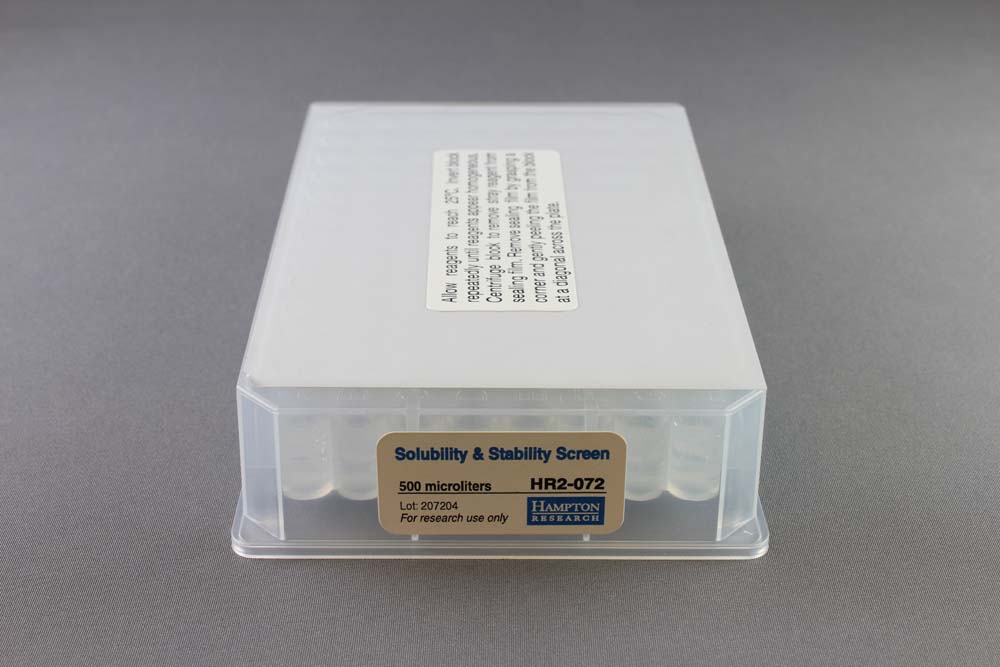Hampton Research蛋白结晶试剂盒






Products > Optimization Screens > Solubility & Stability Screen > Solubility & Stability Screen
Solubility & Stability Screen
Applications
- A solubility screen, a stability screen, an additive screen for protein assays including ThermoFluor and crystallization
- Preformulation screening
- Sample buffer optimization for crystallization, cryo-electron microscopy, and NMR
Features
- Compatible with Thermofluor, Differential Scanning Fluorimetry (DSF), and Protein Thermal Shift assays
- 96 sterile filtered reagents
- 17 classes of reagents and excipients
- Highly concentrated (10x) reagent formulation
- Developed at Hampton Research
Description
Solubility & Stability Screen is designed to assist in the identification of solution conditions which promote protein solubility and stability, and minimize protein precipitation. Solubility & Stability Screen is a solubility screen, a stability screen, and may also be used as an additive screen in the presence of a crystallization reagent.
The Hampton Research Solubility and Stability Screen can evaluate protein solubility, stability and crystallization in the presence of 94 different chemical additives sampling 17 different classes of reagents plus two controls.
Protein solubility and stability are universally required in a wide range of applications, including general biochemical studies, the preparation of proteins in pharmaceuticals, structural biology and crystallization.1-11 The preparation of a concentrated, soluble and stable protein sample can often be a difficult task as proteins often aggregate, precipitate or denature.
Thermofluor (also known as Differential Scanning Fluorimetry, DSF and Protein Thermal Shift) provides a rapid, convenient and effective means of identifying subsaturating solution conditions that may also correlate with protein heterogeneity and poor crystallization outcomes.12
Protein solubility and stability is affected by many different chemical factors including pH, buffer type, chemical additives and excipients. pH and buffer type are dominant protein solubility and stability variables and can be evaluated and optimized using the Hampton Research Slice pH kit HR2-070. Slice pH evaluates protein solubility, stability and crystallization versus 20 different buffers over the pH range 3.5-9.6. Chemical additives influencing protein solubility and stability can be evaluated using the Solubility & Stability Screen.
It is widely accepted that protein solubility and stability can be increased by the use of chemical additives.5,15 Seventeen classes of reagents are sampled by the Solubility & Stability Screen and each of these classes has been reported as important in improving sample solubility and stability.2-11
The Solubility & Stability Screen is a set of 94 high purity reagents formulated in high purity water (NCCLS/ASTM Type 1+) at 25°C and are 0.22 micron sterile filtered. The 94 solubility and stability reagents are formulated at 2 to 10 times their recommended working concentration. The remaining two reagents are water and a negative (TCA) control. A water control demonstrates the effect of diluting sample as well as sample buffer concentration. TCA, the negative control, demonstrates total sample precipitation, loss of sample solubility and loss of sample stability. The effects of the Solubility & Stability reagents can be compared with this negative control to assist in the identification of reagents promoting sample solubility and stability. 500 microliters of each reagent is supplied in a sterile 96 well polypropylene Deep Well block. The Solubility & Stability Screen reagents are compatible with the sitting or hanging drop vapor diffusion, microbatch, free interface diffusion, sandwich drop vapor diffusion, and dialysis crystallization methods utilizing water soluble reagents.

Click to Zoom In
CAT NO
HR2-072
NAME
DESCRIPTION
0.5 ml, Deep Well block format
PRICE
$276.00
cart quote
Support Material(s)
 HR2-072 Solubility & Stability Screen Documents
HR2-072 Solubility & Stability Screen Documents HR2-072 Solubility & Stability Screen SDS
HR2-072 Solubility & Stability Screen SDS Solubility & Stability Screen Formulation and Scoring Data
Solubility & Stability Screen Formulation and Scoring Data Related Item(S)
- Individual Solubility & Stability Reagents
References
1. Preparation and analysis of protein crystals. Alexander McPherson. 1982 John Wiley and Sons, Inc.
2. A straight-forward method of optimizing protein solubility for NMR. Peter W.A. Howe, Journal of Biomolecular NMR 30: 283-286, 2004.
3. Rapid determination of protein solubility and stability conditions for NMR studies using incomplete factorial design. Demene, H. et al. Journal of Biomolecular NMR (2006) 34: 137-151.
4. Dissolution of protein aggregation by small amine compounds. Takagai et al. Science and Technology of Advanced Materials 4 (2003) 55-59.
5. Detection and prevention of protein aggregation before, during, and after purification. Sarah E. Bondos and Alicia Bicknell. Analytical Biochemistry 316 (2003) 223-231.
6. Ionic liquid 1-butyl-3-methyl imidazolium tetrafluoroborate for shotgun membrane proteomics. Sun et al. Anal Bioanal Chem (2010) DOI 10.1007/s00216-010-4381-5.
7. Stabilization of proteins by low molecular weight multi-ions. Middaugh et al. Journal of Pharmaceutical Sciences, Vol. 91, No. 10, October 2002.
8. Inhibition of aggregation side reactions during in vitro protein folding. Eliana De Bernardez Clark, Elisabeth Schwarz, Rainer Rudolph. Methods in Enzymology Volume 309 page 228 (1991).
9. Refolding a glutamine synthetase truncation mutant in vitro: Identifying superior conditions using a combination of chaperonins and osmolytes. Paul A. Voziyan, Lalita Jadhav, Mark T. Fisher. Journal of Pharmaceutical Science Volume 89 page 1036 (2000).
10. Chemical Chaperones Regulate Molecular Chaperones in Vitro and in Cells under Combined Salt and Heat Stresses. Goloubinoff et al. J. Biol. Chem., Vol. 276, Issue 43, 39586-39591, October 26, 2001.
11. Effect of additives on protein aggregation. Shiraki et al. Current Pharmaceutical Biotechnology, 2009, 10, 400-407.
12. A thermal stability assay can help to estimate the crystallization likelihood of biological samples. Marquez et al. Acta Cryst. (2011). D67, 915-919.
13. The combined use of the Thermofluor assay and ThermoQ analytical software for the determination of protein stability and buffer optimization as an aid in protein crystallization. Kevin Phillips and Andres Hernandez de la Pena. Current Protocols in Molecular Biology 10.28.1-10.28.15 April 2011.
14. Thermofluor-based optimization strategy for the stabilization and crystallization of Campylobacter jejuni desulforubrerythrin. Romao et al. Protein Expression and Purification 81 (2012) 193-200.
15. Optimization of protein solubility and stability for protein nuclear magnetic resonance. Bagby S, Tong KI, Ikura, M. Methods Enzymol. 2001;339:20-41.
16. High-Density Miniaturized Thermal Shift Assays as a General Strategy for Drug Discovery. Pantoliano et al, Journal of Biomolecular Screening, Volume 6, Number 6, 2001.
17. Thermofluor-based high-throughput stability optimization of proteins for structural studies. Ericsson, U.B. et al, Anal Biochem. 2006 Oct 15;357(2):289-98. Epub 2006 Aug 10.
18. Chemical screening methods to identify ligands that promote protein stability, protein crystallization, and structure determination. Vedadi, M. et al, Proc Natl Acad Sci U S A. 2006 Oct 24;103(43):15835-40. Epub 2006 Oct 11.
19. Comparison of fluorescence and light scattering based methods to assess formation and stability of protein-protein complexes. J. Kopec, G. Schneider. Journal of Structural Biology 175 (2011) 216-223.


Hampton Research, first in crystallization since 1991, developing and delivering crystallization and optimization screens, reagents, plates, and other tools for the crystallization of biological macromolecules, including proteins (antibody), peptides (insulin), and nucleic acids (DNA).
- Products
- Gallery
- My Account
|
|
|
- Contact Us
- Quick Order
- Support
|
- Privacy Policy
- Terms and Conditions
|
- Products
- Gallery
- My Account
- Support
- Contact Us
- Quick Order
- Privacy Policy
- Terms and Conditions
|
|
|
|
|
|
|
© 2021 HAMPTON RESEARCH CORP.
| Website by Skyhound Internet




